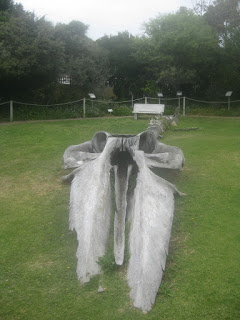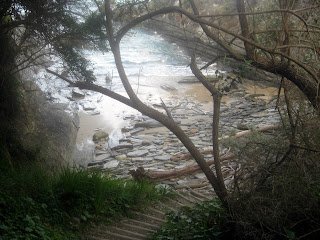The southern coast of South Africa, roughly between Mossel Bay and Plettenberg Bay, is known as the Garden Route. For quite some time, Kathy and I talked about seeing it for ourselves. One long weekend in October, we did just that. We drove to Knysna, stopping in Graaff-Reinet, where we had lunch at a lovely cafe called Polka.
The last portion of that drive was a mountain pass. Here's a bit of that...
In Knysna, we stayed at the Inyathi Guest Lodge. Though located in town, it still had a lush, almost tropical feel.
The weather was a bit overcast when we arrived, but the harbor on which Knysna is situated was still lovely.
Our first full day on the Garden Route, we visited Mossel Bay, where we visited the Bartholomeu Dias Maritime Museum - named after the Portuguese explorer who landed there more than 500 years ago. On the grounds, we saw this whale skull. Huge!
We visited the aquarium.
And this replica of Dias' caravel that made the original voyage. The replica had actually been sailed down from Portugal to celebrate the 500 year anniversary of Dias' arrival.
The ship was cool, but shockingly small. I cannot imagine sailing it that far on the open sea.
In movies, the captain's quarters are always grand, with plenty of room. Not so on this caravel.
The crews' quarters were even more cramped and crowded.
Still, it was an awesome sight, and I enjoyed wandering around on board, exploring the details and admiring the work that went into building it - and imagining the work that must have gone into sailing it.
We even met some curious locals, known as rock dassies.
This is how close Kathy got!
We stopped in Timberlake Organic Village for lunch on our way back.
That evening we went on a boat cruise out to the entrance to the Knysna harbor, a pass called the Heads.
Next day, we headed east from Knysna, stopping in at Monkeyland (how could we not visit a place called "Monkeyland"?), where this little guy wanted to check us out prior to our tour.
As we sat in the outdoor waiting area, we heard something up on the roof. Turns out the metal roof was a warm resting place for a howler monkey and some of its pals.
The black howler monkey decided to give us a closer look, and gnaw a bit on an eave.
During the formal tour, we saw squirrel monkeys.
And capuchin monkeys.
Being that close to monkeys is quite amazing!
I call this one "Two Monkeys".
Monkeyland also had one type of ape, a white handed gibbon. He treated us to quite a show.
Apparently, the gibbon and one of the howler monkeys have become buddies.
Ironically, we also got our best view of ring-tailed lemurs there. We had seen many lemurs in Madagascar, but not this most famous type.
Look how close this one got:
Just look at that tail!
They are cute.
We also saw this black-and-white ruffed lemur, which at first glance appeared to be an indri but was not.
On our way out, we saw this precious site: a family of howler monkeys.
That day, we also visited Tsitsikamma National Park, which was breathtaking. So much so that we both had to pose in front of its shoreline.
And then together.
The trail we followed was more of an extended boardwalk, winding up and down the rocks and through the trees.
We also admired the local flora and fauna.
This was my favorite part of the trail! (Yes, that is me on that bridge.)
Here is a brief video that I hope will give you some small sense of the place beyond what still images can do.
Of course, the still images are fairly telling, too.
Especially when they feature my beautiful wife!
After returning from the trail, we found a tranquil spot to grab a couple of cool drinks.
And some dassies on the lawn to watch as we drank them.
I can say with some confidence, that if the opportunity arises, we will return to Tsitsikamma. In fact, we have talked about how cool it would be to stay there, in the park, as they do have some lodging on site.
I was also again reminded how fortunate we are as we passed townships along the way. These townships are almost unimaginable, with thousands of people living in little tin or concrete shacks, right up against one another, usually without any electricity or running water.
I am so thankful that I have this amazing life and Kathy to share it with.






































































No comments:
Post a Comment